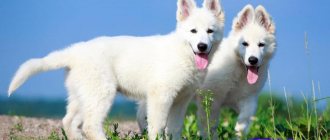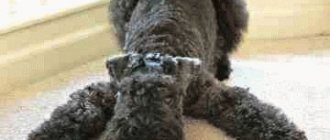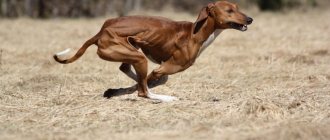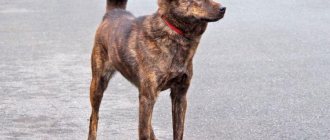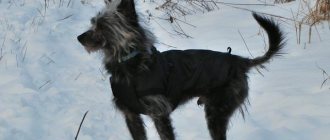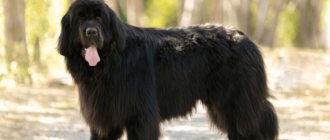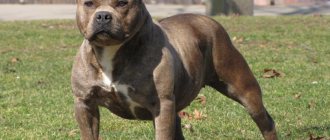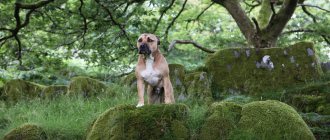Description of the breed
Alabai is an ancient breed of dog originally from Central Asia, which originated more than 4 thousand years ago. They were not bred artificially; the breed was formed naturally and as a result of folk selection. Such dogs have been used since ancient times by Central Asian shepherds and were quite widespread: from the Caspian Sea to Western China, from Afghanistan to the south of the Urals. (Species of Alabaev)
Main characteristics:
- Height: 60–75 cm.
- Weight: 45–77 kg.
- Characteristic color: white, gray, black, various shades of fawn, brindle.
- Lifespan: 11–15 years.
- Coat length: 4–8 cm, hard coat with thick undercoat.
- Price per puppy: $150–200.
It can be seen that Alabai has very impressive characteristics. A dog weighs almost the same as an adult. The wool is thick and helps keep you warm in all weather conditions. Overall the breed is of a high level. Accordingly, the price will be rather high.
What is it also called
Alabai comes from the words: “ala” - black spots, “bai” - rich, literally - rich in black spots. This is a secondary name; it is correct to call this breed a Central Asian Shepherd. Also common names are: wolfhound, Turkmen alabai, Turkmen wolfhound, Asian, Turkmen shepherd dog .
History and origin
The Asian appeared through folk selection from a mixture of the Tibetan mastiff and the herding dogs of the nomads of Central Asia, as well as Mongolian shepherd dogs. The nomads selected individuals with the best qualities - the hardiest, largest and strongest. Thus, a similar breed appeared, distinguished by its ability to guard and protect its owners.
In the 1930s, factory work with these dogs began in the Soviet Union. It was planned that they could be trained en masse and used to protect government facilities. It turned out that the task is difficult to implement due to the character and psychology of the Alabais. They require an individual approach.
The new standard was assigned in 2010.
Reference. This breed is not very popular today, because purebred Alabai in Turkmenistan are considered a national treasure and are prohibited for export.
What does it look like
- The muzzle is massive and wide, with pronounced volume, filled over the entire surface. The forehead is not convex. The transition from the forehead to the muzzle is weakly expressed. The nose is large, black or brown.
- The eyes are round in shape. Eyes wide apart. Dark color.
- The ears are small, hanging, triangular, low set. They are often docked.
- The body is powerful. Asians have a short neck, which turns into a wide and deep chest. The ribs are rounded and the back is straight, strongly built and broad. The loin is short, convex, and wide when viewed from above. The back of the dog's body is muscular, almost horizontal. The pelvis is located higher than most dogs. The belly is tucked in.
- The limbs are strong. The bones are powerful. The angles of the limbs are average. The paws are strong, compact, oval shaped.
- The tail is saber-shaped and usually docked to medium length. The dog almost always keeps it near the ground.
- The coat is coarse, straight in appearance and feels harsh. It is divided into 2 categories: long wool (about 7–8 cm) and short (3–4 cm), smooth. The undercoat is quite thick.
- The color can be black, gray, brown, whitish, red, fawn, as well as brindle, piebald or speckled. Unacceptable: liver, chocolate and blue colors.
Although the breed was not formed through artificial selection, its appearance was shaped over centuries under the supervision of nomads. They created conditions under which only the parameters described above were preserved. These people carefully ensured that new generations of puppies had a powerful physique that would help them perform their duties more efficiently.
Peculiarities
When dealing with this breed, you need to pay attention to the animal’s not particularly flexible character and needs. It is important to devote a lot of time and effort to training, because otherwise the dog may get out of control of the owner.
How it barks
Such dogs bark quite often, thus they warn the owner about strangers or other dogs in the territory, and they also scare away strangers by barking and growling.
The largest alabai in the world
This dog lives in the Stavropol region of Russia. His name is Bulldozer. The owner's name is Alexander Khudyakov, he is a famous breeder. The bulldozer justifies the title of a giant - standing on its hind legs, it exceeds 2 meters in height, and its weight is 130 kilograms.
By the age of nine, Bulldozer has countless awards. Starting from the age of 3 (and it is believed that it is at this age that Alabai becomes an adult), he began to enter the rings. The list of his achievements is very long, and here is an incomplete listing of what this giant has achieved: he is the national champion, the RKF champion, the Pride of Russia, three times CACIB champion, twice KCC champion, multiple winner of various international competitions and so on. His descendants and even grandchildren are also quite successful.
Bulldozer's character is calm and balanced; outside of the fight in the ring, he has never bitten anyone. He looks at people slightly condescendingly, with wisdom. He will never look away first. His owner says that owning an Alabai is quite risky, he will not obey, and will not accept handouts. Raising a dog is difficult, but if it succeeds, the pet will become the most faithful and kind friend.
Lifespan
Dogs of this breed live from 11 to 15 years. It depends on the pedigree, certain diseases and lifestyle. Your pet will live longer if you take it for walks more often and follow a diet.
In its natural environment, an alabai will live 16–17 years, since it is not limited in mobility and is often in the fresh air.
Nothing in such conditions will limit the possibilities of a healthy and active life.
At home, the duration can be reduced by poor diet, routine, and stress. Also, locking yourself within four walls will have a negative impact on your pet’s life.
ATTENTION! If for some reason your Alabai is forced to live in an apartment, he needs at least two or three walks a day for a long time.
Evil or not
Alabai is a very proud, balanced and self-confident dog. He is not overly aggressive and will never attack a person who does not pose a threat.
He is not particularly friendly towards other people's dogs, he can easily attack, but he is quite friendly towards those who grew up in the same house with him. It will not attack strangers, but will scare away with an angry growl. He treats children very well, can play with them and will become a loyal protector.
Can it attack the owner?
Alabai is very proud, so the first question is how to become his master. It is necessary to achieve respect in his eyes. Only when he sees a real leader in a person will he begin to consider him his master. Now he will perceive the person as a leader and will never harm him, being a faithful protector.
Advantages and disadvantages
The CAO is a very specific breed. She has both pronounced advantages and some disadvantages that can make training difficult.
| pros | Minuses |
| Hardy, strong, loyal dog. Provides protection and security. Distrustful of strangers. Has a balanced character. Friendly with children. | Independent, independent, not suitable for everyone. Difficulties of education. Requires frequent walks and a large area (a country house with a large plot is perfect). |
IMPORTANT! If you are not sure that you can handle the temperament of this breed, hire a dog training specialist and take an Alabai training course.
History of the Alabai breed
Some scientists say that the first mastiffs were domesticated more than 6 thousand years ago. And this is quite logical, given the peculiarities of the life of Asian nomads, who earned their living by raising cattle and needed brave and devoted helpers. Moreover, the four -legged comrade was not only obliged to perform the functions of an observer of the flock, but also to protect it from various animals, take part in hunting and even military operations. Therefore, it is not surprising that both the disposition and appearance of the shepherd dogs were, to put it mildly, fighting-like. It was these qualities that Asian tribes then tried to cultivate during the breeding of other breeds, including the Alabai.
Breeding domestic dogs among nomads was at a fairly high level. Thus, almost every dog (of which, according to archival data, there were approximately 8 thousand) had a personal curator who provided the pet with proper care, nutrition, etc. And issues of breeding and selection were directly within the competence of the khan and his close relatives.
This attitude made it possible not only to clearly control the breeding process, but also made it possible to select only the best representatives of the breed and remove the weak ones. At the same time, dogs that showed aggression towards humans were also rejected. Since, on the one hand, the animal must be fearless , brave and strong, but at the same time, be able to recognize the advantage and obey its owner. Since the dogs at that time were not in enclosures, but moved freely around the territory and could frighten or even harm children or residents of the village.
The following important qualities were cultivated in representatives of the species known as the Alabai or Central Asian Shepherd Dog:
- physical strength and devotion;
- the ability to protect the owner and guard the flock;
- courage and courage.
This beast developed not only to be brave and strong, but also capable of analyzing the situation and making the right decisions to protect property and people directly. Since often nomads, leaving for war or hunting, left their wives and children under the care of their four-legged friends. And judging by the results, they coped superbly with such an important and complex task.
Since there were a large number of nomadic tribes, and each had their own breed, there is some confusion in the names. Officially, the Central Asian Shepherd Dog breed was registered with the FCI under this definition. Despite the fact that owners and dog handlers often call their dogs Turkmen Alabay or Kazakh Wolfhound , they are all required to meet a common standard that is recognized throughout the world.
To get a first impression about this formidable and large animal, just look at the photo showing its predecessors - mastiffs. By the way, the Central Asian Shepherd Dog itself is in the top 10 and is the strongest and largest in the world. But there is no need to confuse aggressive and strong . Since reviews from the owners indicate that Alabai is not aggressive (at least it does not show aggression if it is not necessary).
Despite the fact that the history of this dog goes back thousands of years, this breed was officially recognized only in 1988 by experts from the international canine organization. this type of dog waited so long for its official recognition precisely because of its naturalness, since the breed appeared without the help of artificial selection. Therefore, we can safely say that this very smart and large animal is nature’s gift to man.
Character
The Central Asian Shepherd got its character as a result of national selection. The nomads kept only dogs with a balanced character and strong spirit in order to guard and protect their owners and herds. Central Asians are very capricious and proud, they are not easy to tame, and they are not suitable for everyone. Genetically developed distrust of other dogs and people.
Alabai is independently capable of making informed decisions and exhibits leadership qualities. It is important to ensure that self-confidence does not go beyond limits, otherwise the dog may not recognize the owner and, being overly selfish, will bring inconvenience to the family. If you raise an Asian correctly and responsibly, then he will grow up to be wayward, but a devoted and faithful watchman. They are also very clean and take care of things. They love to swim and try not to get too dirty on walks.
Bitch and male
When buying a pet of this breed, one of the key questions is whether to buy a female or male puppy. The answer is simple - it all depends on your goals. If a dog is taken to guard the house and owners, for protection or to help herd livestock, then a male dog will be the best option. If you need a dog as a faithful friend, and you need to minimize (as far as possible with this breed) the problems of proper quality education, then it is better to take a bitch. Especially if there is a small child in the house, because by their nature, females relate better to children.
| Bitch | Male |
| More calm and balanced, flexible. If there are children in the house, a female dog will be better suited. | More capricious, aggressive, suitable for guarding and protection. The owner must show great self-confidence. |
However, the difference is not so significant. The above does not imply that the bitch will perform worse in the role of a faithful guard, and the male will not obey commands.
Usage
Due to their nature, Central Asians are well suited for guarding and defense, as well as for hunting. Here are the most popular “professions” for this breed:
- Shepherd. For a long time, nomads used these giants to protect livestock from wolves and to keep an eye on the herd. And in this role the dog feels very comfortable, because this is his original historical purpose. He copes with his duties in office very well.
- Security guard. Alabai is extremely territorial. He does not allow anyone onto his land. If you live in a private house, then it will perform the role of security well. You won't have to worry about the safety of your home at all.
- Hunter. This breed is distinguished by its strength and ability to make quick decisions on its own. For this reason, they are more than suitable for hunting. They have enough intelligence, strength, and dexterity for productive hunting.
Alabai or wolf - who wins
Alabai's middle name is wolfhound. The name speaks for itself. Under natural conditions , Central Asians, especially shepherd dogs, often faced wolves in fierce battles and almost always won . This was their main task and they undoubtedly coped with it.
Who is stronger: Alabai or tiger
Tigers are not at all the natural enemies of Alabais; it is very rare to see how these animals confront each other, but, most likely, their strength is equal . Although with proper training, the dog has every chance of winning.
Hunting for large predators
The Alabai is not a specialized occupation, but sometimes this dog is used to hunt bears and more often wolves. Today, such activity is not often practiced, but several centuries ago, nomads used their strength and powerful physique to catch wolves and other predators.
Fighting dog
Alabai is not officially considered a fighting dog, but dog fights are constantly held in Turkmenistan. They have very strict rules, no one fights to the death, and even serious damage is not allowed. The winner is the dog that was able to grab the other by the scruff of the neck and hold it for a sufficient amount of time.
Nuances of apartment life
For large breeds, it is important to have sufficient space, so breeders recommend keeping Central Asian Shepherds on private property. Despite this, an alabai can be started in a city, but subject to strict adherence to a number of mandatory conditions.
Make sure you have your own corner. The selected location should not be in a draft or near heating devices. Build a bed. Do not use soft mattresses. They are harmful to the health of the animal and require more painstaking cleaning. Give preference to a flat wooden surface covered with canvas fabric.
Alabai in an apartment should have his own large bed
IMPORTANT! Don't skimp on sizes. The pet must fit on the bed in any position.
Monitor the amount of physical activity. A shepherd dog living at home needs longer and more frequent walks. Adult dogs need 1.5-2 hours twice a day, and puppies need 30 minutes 4 times a day.
Contact a dog trainer. Keeping an alabai in an apartment is a big responsibility. The dog must understand the boundaries of what is permitted and strictly follow the instructions of its owner. Please note that representatives with long hair require more care and maintenance. Frequent shedding and intolerance to high temperatures will turn indoor life into a real punishment not only for the owner, but also for the shepherd.
Famous owners
The breed is very popular among government officials and artists.
Alabai Putin
On October 11, 2021, President of Turkmenistan Gurbanguly Berdimuhamedov presented Russian President Vladimir Putin with an Alabai puppy, the country’s national treasure. The puppy was given the nickname Faithful, which characterizes his breed very well.
Asian Kadyrov
Ramzan Kadyrov is the owner of an Alabai named Tarzan, who lives at his residence in Grozny. In 2013, it happened that the dog ran away due to unclear circumstances. But she was found, and Kadyrov rejoiced at this event very sincerely, which shows what place the pet occupies in his life.
Anita Tsoi and her dogs
Anita took two Alabais at once - a red spotted boy, Yelash, and a white girl, Umka. She and her family dote on them. The singer says that her dogs are very friendly, but they treat strangers with caution and even a bit of aggression.
Anatoly Chubais and Jack with gold teeth
Chubais also has an alabai, but due to his busy schedule, he cannot spend as much time with it as he would like. It is known that SAOs are incredibly loyal dogs, and therefore Jack was very homesick for his owner. Because of this, he constantly gnawed at the metal mesh that covered the enclosure. So he damaged his two lower teeth.
Anatoly Chubais decided to put dentures on the dog. Until this moment, no one had performed such operations, so finding a specialist was difficult. Nevertheless, there was a prosthetist who took on such work. The total amount came out to be decent. $200 for each dental prosthesis, the cost of anesthesia, two visits home to examine Jack - all this totaled $1000.
As a result, we can say that Alabai are very difficult to raise and maintain. It is important to be aware of all the risks you are taking when choosing this breed. But if the upbringing goes correctly, then you will become the owner of a very loyal and disciplined dog.
